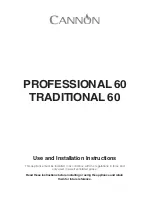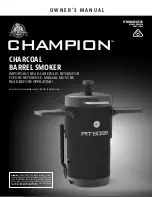
19
Condensation forms in the oven
Have you pre-heated the oven?
Condensation is less likely to form when the oven or grill is
pre-heated before use.
Has the food been frozen?
Thawed food always contains more water than fresh food.
The cooker is A rated, this means the oven has to be air
tight. Excess water will find its way out via the lowest point
sometimes through the door seal, especially when cooking
for a long time especially on temperatures below 180ºC.
Smoke is generated in the oven
Have you selected the right cooking temperature?
Are you cooking high fat content foods? Do you
rarely use the grill?
There may be residue left from a previous cooking session.
Do the oven interior and/or stay clean liners need to be
cleaned?
Remember to reduce the oven temperature by 20°C if using
a fan function with a recipe designed for conventional
cooking.
Use high sided dishes to contain fats and splashes. Clean
the oven interior if necessary.
Remember to remove and clean the grill pan after use.
Leave the grill on for a few minutes after grilling or roasting
to burn off fatty deposits from the oven roof.
If you have been cooking food at low temperatures, the stay
clean liners may TAR. Turn the oven up to 200ºC for one
hour to clear this.
Oven surfaces should be cleaned regularly to prevent build-
up of cooking residues.
The door seal has split or perished
Are you leaving the grill pan or foil at the bottom of the oven?
This may cause the seal to overheat and become brittle.
Have you used caustic oven cleaners on or near the door
seal?
Always remove the grill pan when not in use as it can restrict
airflow around the oven.
Contact our spares department for advice and a
replacement seal if necessary. The seal can be changed
easily without booking an engineer visit, by stretching and
engaging the clips in the corners
Cleaning Tips
Always disconnect the electricity supply to the appliance before
any cleaning takes place. Never allow fat or oil to build up on
any surface, particularly on oven bases and oven trays, as this
can lead to permanent staining or the risk of a fat fire.
Clean the outside of your cooker with a dish cloth and washing
up water. Dry and buff with a micro fibre cloth or an old hand
towel to remove finger prints
Cleaning your gas hob
Do not use any abrasive cleaners on the stainless steel
hotplate.
Wipe with a soft cloth using warm water and washing-up liquid.
Whilst still damp polish dry with a micro fibre cloth or old hand
towel.
For stubborn baked-on stains use a non-abrasive stainless steel
cleaner.
Always work in the same direction as the grain of the stainless
steel, rinse well and polish dry.
Pan supports and burner caps are made from cast iron with a
protective coating of acid resistant enamel.
Always allow pan supports and burner caps to cool completely
before immersing in water.
Wipe with a soft cloth using warm water and washing-up liquid.
When placing the pan supports on the hotplate, always ensure
the support with the shortest arms is fitted onto the triple ring
wok burner.
Brass burner rings
Use washing up water and a nylon scourer. Rinse well and dry.
After cleaning, ensure that the burner holes are dry and not
blocked with water or soap.
Alloy burner bases
Clean with soaped wire wool. When the entire fat residue has
been removed, polish with brass or metal polish. The more you
polish them the longer they will stay clean.






































